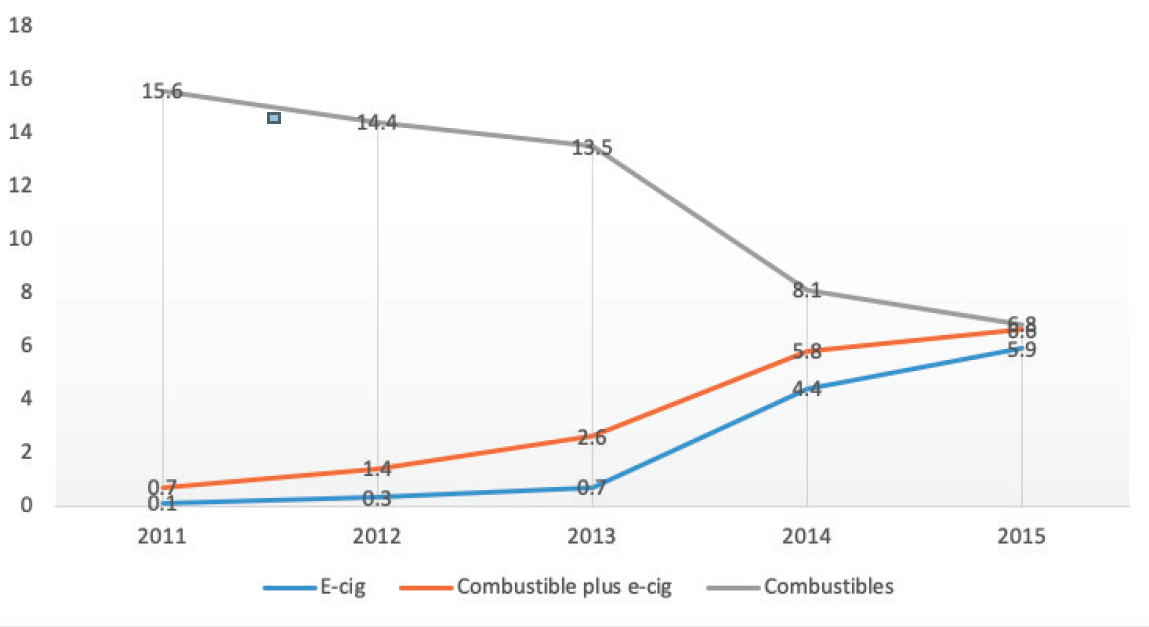The use of e-cigarettes, often referred to as vaping, has been rising at worrying rates, particularly among adolescents and young adults.
E-cigarette use increases the risk of ever using combustible tobacco cigarettes as well as heavier use of both products over time. Progression towards more frequent use of e-cigarettes and combustible tobacco use increases the risk of nicotine dependence, and it is important that insurers have a thorough understanding of the evolving health risks.
Introduction
Tobacco use continues to be one of the world’s biggest health problems. One in every five adults worldwide today smokes tobacco.1
Although tobacco’s global burden of disease is extremely high, many countries have put smoking-related restrictions in place that are successfully reducing mortality from smoking-related diseases. Indications are, however, that the smoking epidemic may be shifting into to one of vaping. The fast-rising use of electronic nicotine delivery systems (ENDS), more commonly referred to as e-cigarettes, especially among the young, is causing considerable concern among health authorities. E-cigarette use has been shown to reduce several health risks among former smokers, but the use of e-cigarettes should be temporary as the long-term adverse effects are yet to be established.
Prevalence of Use
In Europe alone, approximately 48.5 million individuals have used an e-cigarette at least once. About 7.5 million are current users, and the largest subgroup consists of those who use both e-cigarettes and conventional cigarettes.2
In the U.S., adult e-cigarette use rose from 5.2% in 2017 to 7.6% in 2018 – a 46.2% increase.3 While older U.S. adults may still be more likely to smoke conventional cigarettes, adults under age 30 are increasingly more likely to use e-cigarettes.
Table 1
U.S. Smoking Habits 20194
Category | Cigarette smoking (%) | E-cigarettes (%) |
|---|
By Gender |
Men | 15 | 9 |
Women | 15 | 6 |
By Age Range |
18-29 | 14 | 19 |
30-49 | 19 | 8 |
50-64 | 18 | 3 |
65+ | 7 | <1 |
The 2018 National Youth Tobacco Survey (NYTS) found a sharp reversal of overall past declines in youth tobacco use between 2015 and 2017. 5 In 2018, 20.8% of high school students and 4.9% of middle school students reported current e-cigarette use. By 2019, this had increased to 27.5% and 10.5% respectively. Even though the newly released figures for 2020 show a decrease to 19.6% and 4.7%, 3.6 million U.S. youths still currently use e-cigarettes.6
Figure 1
Percentage of U.S. high school students who have ever used tobacco products, by product type (2011-2015)5

Source: FD
The Switch to e-Cigarettes
E-cigarettes were originally designed as a smoking cessation aid, but many young people now begin smoking with e-cigarettes unrelated to quitting conventional cigarettes. Among adolescents, vaping is strongly associated with increased risk of future cigarette smoking and moderately associated with long-term cigarette use.
While e-cigarettes are promoted as being less harmful than conventional cigarettes, this does not mean that they are free of health risks.7 The World Health Organization (WHO) is recommending that its members which have not yet banned e-cigarettes consider treating them as a harmful product.4 More than 30 countries around the world have already banned the sale of e-cigarettes, and several more have banned only the sale of flavored e-cigarettes.8
Health Effects
The liquid used in e-cigarettes, known as e-liquid, e-juice, or vape juice, contains four major compounds: nicotine, in average concentrations of 11 mg/ml; glycerol (average concentration 37 g/100 g); propylene glycol (average concentration 57 g/100 g); and ethylene glycol (average concentration 10 g/100 g). Flavorings such as banana or vanilla are added to e-liquids to make them more attractive, which risks encouraging adolescents to try e-cigarettes. Many users start with tobacco-flavored e-cigarettes, but later switch to other flavors.9
Evidence to date shows that e-cigarette use can cause several adverse health effects. Long-term exposure to carbonyl compounds such as formaldehyde, which are present in e-cigarettes, are known to increase the risk of cancer in humans. Formaldehyde is also associated with the increased cardiovascular risk of tobacco smoking.10
The nicotine in e-cigarette liquid can increase risk of tachycardia as well as ventricular arrhythmias.11 A study by Bhatta, et al. on e-cigarette use and myocardial infarction (MI) in the U.S. found that every-day (adjusted odds ratio, {OR} 2.25) and some-day (OR 1.99) e-cigarette use were independently associated with increased odds of having had an MI. It also noted that dual use of e-cigarettes and conventional cigarettes was more harmful than use of either product alone, as users are exposed to high levels of toxicants.12
Alzahrani, et al., in their 2018 study, found that daily e-cigarette use was independently associated with a 70% increased risk of MI compared to those who have never used e-cigarettes. It also found that the risk of MI in a current daily dual user was more than four times that of a never-smoker, indicating that dual use of e-cigarettes and conventional cigarettes may be more harmful than using only one product.13
A study by Parekh, et al. published in January 2020 found that current dual use was associated with nearly a threefold risk of stroke compared to non-smokers, and that dual use was associated with almost double the risk of stroke versus only conventional cigarette use.14
Product Use
User habits such as puff duration, puff intervals, and the power of the e-cigarette device, in addition to the concentration of liquid nicotine, affect the amount of aerosolized nicotine inhaled, making it difficult to quantify adverse effects of e-cigarette consumption. Puff duration is directly related to the nicotine content of the e-cigarette, and blood nicotine levels are influenced by the way an e-cigarette is puffed. The ability of e-cigarettes to deliver high doses of nicotine compared to conventional cigarettes is of particular concern in adolescents and young adults.15
Newer generation e-cigarette devices can achieve nicotine levels that are the same or higher than conventional cigarettes, increasing the potential for nicotine addiction as well as its adverse effects. One e-cigarette product delivers more than 50 mg/mL of nicotine in the standard U.S. and Canadian version, but in Europe, the European Tobacco Product Directive limits nicotine levels in e-cigarettes to 20 mg/mL, so the product contains less than half that nicotine concentration.15
If rates of e-cigarette use continue to rise in young adults and adolescents, the long-term harmful consequences of nicotine exposure are likely to rise accordingly. Early exposure to nicotine increases the risk of long-term dependency and the ability to quit becomes less likely. Studies have also shown that nicotine has negative influences on adolescent brain development, resulting in deficits in attention and cognition as well as mood disorders.10
The extraction process of nicotine from tobacco, as well as poor quality control of e-liquid products, may leave harmful impurities such as lead and nickel in the end product. Aerosolized solvents produced by e-cigarettes such as propylene glycol are known respiratory irritants. Inhaling propylene glycol can increase the risk of developing asthma, while high volumes of particles resulting from vaping liquid’s aerosolized solvents can deposit in the respiratory system and cause toxic effects on the lung epithelium.
Flavoring agents such as diacetyl and acetyl propionyl, both of which are known to adversely affect lung function if inhaled, have been associated with a decline in respiratory function in e-cigarette users. A number of people in the U.S. have developed a severe pulmonary disease named e-cigarette or vaping product use-associated lung injury,” or EVALI. The disease was first recognized and identified in 2019. Vitamin E acetate, also found in vaping liquid samples tested by the U.S. Food and Drug Administration, is strongly linked to the EVALI outbreak. Previous research suggests that when vitamin E acetate is inhaled, it may interfere with normal lung functioning. As of the final update published in February 2020, EVALI has resulted in 2,807 cases and 68 deaths.10
Conclusions
Smoking patterns continue to change over time, including daily consumption amounts, the type of product used and dual use of nicotine products.
There is still considerable uncertainty surrounding the potential health impacts of e-cigarettes. To date, evidence of the short-term risks of e-cigarette use is limited and long-term risks cannot yet be identified. New e-cigarette and e-liquid products are attracting more young adults and adolescents, exposing them to the harmful effects of nicotine and increasing their risk of long-term dependence. Studies to date also indicate an increased risk to health from dual use. Preventing tobacco use and the use of e-cigarettes among young people is a key component to ending the tobacco-use epidemic.




